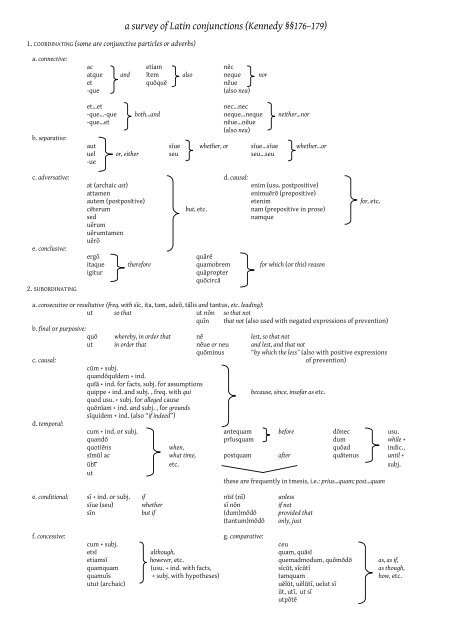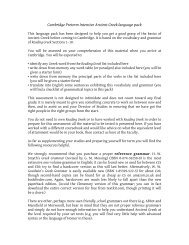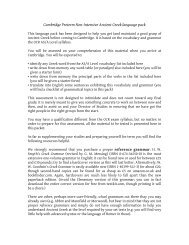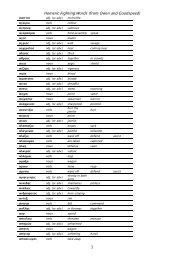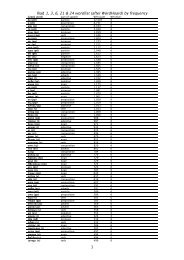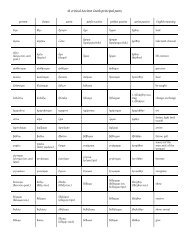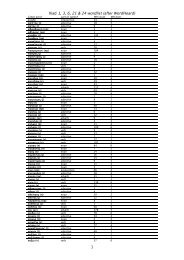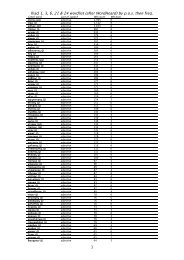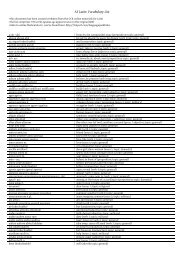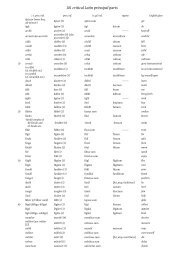Cambridge Preterm Latin language pack
Cambridge Preterm Latin language pack - CW's language page
Cambridge Preterm Latin language pack - CW's language page
You also want an ePaper? Increase the reach of your titles
YUMPU automatically turns print PDFs into web optimized ePapers that Google loves.
1. COORDINATING (some are conjunctive particles or adverbs)<br />
a survey of <strong>Latin</strong> conjunctions (Kennedy §§176–179)<br />
a. connective:<br />
b. separative:<br />
ac etiam n!c<br />
atque and "tem also neque nor<br />
et qu#qu! n$ue<br />
-que<br />
(also neu)<br />
et…et<br />
nec…nec<br />
-que…-que both…and neque…neque neither…nor<br />
-que…et<br />
n$ue…n$ue<br />
(also neu)<br />
aut s%ue whether, or s%ue…s%ue whether…or<br />
uel or, either seu seu…seu<br />
-ue<br />
c. adversative: d. causal:<br />
at (archaic ast)<br />
enim (usu. postpositive)<br />
attamen<br />
enimu$r& (prepositive)<br />
autem (postpositive) etenim for, etc.<br />
c$terum but, etc. nam (prepositive in prose)<br />
sed<br />
namque<br />
u$rum<br />
u$rumtamen<br />
u$r&<br />
e. conclusive:<br />
erg&<br />
qu'r$<br />
itaque therefore quamobrem for which (or this) reason<br />
igitur<br />
qu'propter<br />
qu&circ'<br />
2. SUBORDINATING<br />
!<br />
a. consecutive or resultative (freq. with s%c, ita, tam, ade&, t'lis and tantus, etc. leading):<br />
ut so that ut n&n so that not<br />
qu%n that not (also used with negated expressions of prevention)<br />
b. final or purposive:<br />
qu& whereby, in order that n$ lest, so that not<br />
ut in order that n$ue or neu and lest, and that not<br />
qu&minus “by which the less” (also with positive expressions<br />
c. causal: of prevention)<br />
c(m + subj.<br />
quand&qu"dem + ind.<br />
qu") + ind. for facts, subj. for assumptions<br />
quippe + ind. and subj. , freq. with qui<br />
because, since, insofar as etc.<br />
quod usu. + subj. for alleged cause<br />
qu#n"am + ind. and subj. , for grounds<br />
s%quidem + ind. (also “if indeed”)<br />
d. temporal:<br />
cum + ind. or subj. antequam before d&nec usu.<br />
quand& pr"usquam dum while +<br />
quoti$ns when, qu#ad indic.,<br />
s"m(l ac what time, postquam after qu'tenus until +<br />
(bı etc. subj.<br />
ut<br />
these are frequently in tmesis, i.e.: prius…quam; post…quam<br />
e. conditional: s% + ind. or subj. if n"s" (n%) unless<br />
s%ue (seu) whether s% n&n if not<br />
s%n but if (dum)m#d# provided that<br />
(tantum)m#d# only, just<br />
f. concessive: g. comparative:<br />
cum + subj.<br />
ceu<br />
ets% although, quam, qu)s"<br />
etiams% however, etc. quemadmodum, qu&m#d# as, as if,<br />
quamquam (usu. + ind. with facts, s%c(t, s%c(t% as though,<br />
quamu%s + subj. with hypotheses) tamquam how, etc.<br />
utut (archaic) u!l(t, u!l(t%, uelut s%<br />
(t, ut%, ut s%<br />
utp#t!<br />
N.B. relative forms (e.g. qui) can express result, purpose, cause, condition, concession and comparison, particularly + subj.


